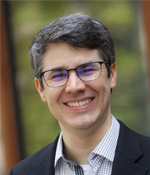
Working for Petrobras, one of the largest integrated oil and gas companies in the world, over the past decade I witnessed two key market forces changing the oil & gas industry. First, investors are putting real pressure on corporations to adopt clear ESG standards and to significantly reduce greenhouse gas emissions. Second, wind and utility-scale solar generation technology have had dramatic declines in costs and significant improvements in efficiency becoming competitive with conventional sources of energy.
Energy transition is a key challenge to the long-term sustainability of the Oil & Gas industry and at Tuck I had the opportunity to deep dive into this important subject. As a Fellow in the Revers Center for Energy, I had direct access to experienced leaders in the renewables space. It was through the Center’s strong network that I was able to have two great summer experiences. First, I joined the business development team of Swift Current Energy, a utility scale developer headquartered in Boston, and later joined the corporate development team of Spruce Finance, a leading owner and operator of a portfolio of distributed solar and residential energy assets in the U.S.
While at Swift Current Energy I had the opportunity to deep dive into the energy transition. I presented to the firm’s partners my research on how the oil majors are approaching energy transition, strategic acquisitions and investment mandates in the renewable energy sector in U.S. and Europe. I found this research so interesting that I decided to approach April Salas, Executive Director of the Revers Center for Energy, with a bold idea: organize Tuck’s first renewable energy case competition! The idea was inviting teams from top business schools around the world to recommend an energy transition strategy to a fictitious oil and gas producer that is looking to transition to a low carbon business. The teams also had to identify one acquisition opportunity that would become the platform for the recommended strategy.
In July, the idea started to take shape. I formed a great team of T’21s and T’22s that believed in my ambitious idea and made it all possible: Alex Krass, Cristian Molina, Gautam Jagannathan, Joe Dalton, Michael Zanko, and Susie Peerson. I can’t thank them enough for making it possible.
The competition was a great success! For the first round, in the beginning of October, we received 15 applications from 12 top MBA Schools. The quality of the teams’ recommendations was impressive! It was very interesting to see their creative solutions to address the problem. Their investment recommendations were also very consistent with the major market trends in the renewables space.
Most teams proposed the acquisition of utility-scale solar developers. Utility scale solar is on track for a record high 2020. Through Q3 2020, solar PV accounted for 43% of electricity-generating capacity additions in the U.S, according to SEIA and Wood Mackenzie. Over the same period wind added 26% and natural gas added 30% new generating capacity. Large-scale solar market is expected to carry the overall industry growth in 2020, representing 70% of all solar capacity brought online. Despite the slowdown in procurement from C&I offtakers, the pandemic has caused virtually no delays in utility project construction.
The other major trend that the teams captured is the rapid growth of the electric vehicle market. Europe and China have been leading the sales of EV market and are expected to be driving the market in the short-term. According to a McKinsey recent report, the market share for electric vehicles in Europe is expected to grow despite of COVID-19 pandemic from 3% in 2019 to 15% in 2022 and the market share in China is expected to grow from 5% in 2019 to 14% in 2022. Even though the U.S. EV market looks vastly different from that in China or Europe (US market is expected to grow from 2% in 2019 to 6% in 2022), stricter emission regulation and governmental incentives brought by the Biden-Harris administration may change that scenario.
For the second round of the competition, five teams were selected to deliver a 15-minute online presentation detailing the recommendations followed by a 10-min Q&A session. The final presentations were evaluated by a panel of experienced leaders in the renewable space: Ammad Faisal (Senior Managing Director of NYC Office) and Aygul Sanzyapova (Associate) from Marathon Capital, Aashna Mehra (Associate) and Jeph Shaw (Principal) from New Energy Capital, Jim Marett (Director of Business Development) and Caroline Mann (Principal) from Swift Current Energy, and Justin Johns (New Energies Renewable Power Finance Manager) and Tom Stokes (Head of M&A and Commercial Financial for the Americas) from Shell.
Overall, organizing this case competition was not only a great learning experience that helped me gain a clear insight into the energy transition challenges that oil & gas companies are facing but it was also a great opportunity to meet fantastic people committed to creating a positive impact in the world through renewable energy. I cannot wait to see next year’s edition of Tuck Renewable Energy Finance Challenge!

Tiago Rosa is a T’21 and a student fellow at the Revers Center for Energy at Tuck. Prior to Tuck, he worked for Petrobras in Brazil as head of the Planning and Control team developing business plans for a portfolio of projects in the upstream division and evaluating investment opportunities. During the summer, Tiago supported the corporate development team at Spruce Finance and Swift Current Energy doing evaluating M&A opportunities, performing project finance modeling and investment research in the renewables space. He holds a B.S. in business administration from Federal University of Bahia in Brazil and a Masters in Oil & Gas Business Management from Brazilian Petroleum Institute.
The Revers Center for Energy supported Tiago’s internship at Spruce Finance through the Career Exploration Fund generously donated by Thad Hill T’95.